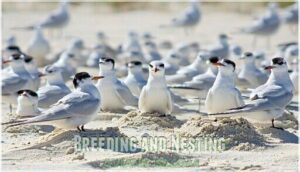This site is supported by our readers. We may earn a commission, at no cost to you, if you purchase through links.
 You’ll recognize an elegant tern by its striking orange bill and shaggy black crest that makes it stand out among coastal seabirds.
You’ll recognize an elegant tern by its striking orange bill and shaggy black crest that makes it stand out among coastal seabirds.
These graceful fliers cruise above Pacific waters from California to South America, diving headfirst to snag anchovies and small fish.
With pale gray wings, white bodies that sometimes show a peachy blush, and that unmistakable pointed bill, they’re easier to spot than you’d think.
They’re highly social birds that nest in massive colonies on islands and beaches, creating quite the spectacle during breeding season.
Their acrobatic fishing displays and distinctive calls reveal fascinating behaviors worth understanding.
Table Of Contents
- Key Takeaways
- Elegant Tern Identification
- Habitat and Distribution
- Behavior and Diet
- Conservation and Status
- Breeding and Nesting
- Frequently Asked Questions (FAQs)
- How do you identify Elegant Terns?
- What is the difference between Elegant Tern and Royal Tern?
- Is the Elegant Tern endangered?
- What are the interesting facts about Elegant Terns?
- What is the difference between elegant tern and royal tern?
- Is the elegant tern endangered?
- How do you identify elegant terns?
- What is the difference between elegant and Caspian Terns?
- What does an elegant tern look like?
- Where does the elegant tern come from?
- Conclusion
Key Takeaways
- You’ll spot elegant terns by their distinctive orange bills and shaggy black crests – these medium-large seabirds stand out among coastal species with their streamlined build and deeply forked tails
- They’re master plunge-divers who hunt from heights of 5-10 meters – you’ll watch them execute precise aerial attacks to snatch anchovies and small fish from Pacific waters
- You’ll find them in massive social colonies along the Pacific Coast – these highly social birds nest in dense groups from California to South America, often partnering with aggressive species for protection
- They’re considered Near Threatened due to their limited nesting sites – with 90% of breeding occurring at just one Mexican island, you’re witnessing a vulnerable species that relies heavily on conservation efforts
Elegant Tern Identification
You’ll find the Elegant Tern stands out as a medium-large seabird measuring 17-20 inches with distinctive orange-yellow bills and graceful flight patterns.
Learning to identify this species requires focusing on key features like bill shape, plumage patterns, and size comparisons with similar terns, which are complete concepts necessary for accurate identification.
Size and Shape
You’ll spot an elegant tern by its medium-large size, measuring 17-20 inches with a distinctive streamlined shape.
Its slender build features long, pointed wings spanning 40 inches and a deeply forked tail.
The bill dimensions are remarkably thin and tapered compared to bulkier royal terns, creating graceful body proportions.
This wing morphology enables their signature plunge-diving style while maintaining elegant flight patterns.
Color Pattern
You’ll notice elegant terns display striking plumage phases throughout the year, with breeding adults sporting pale gray upperparts contrasting beautifully against crisp white underparts.
During winter plumage, their black cap becomes mottled with white streaking, while juvenile markings feature distinctive scaly patterns across their backs.
The bill color shifts from bright orange-red to duller orange tones seasonally, though regional differences remain minimal across their range.
Bill and Plumage
The elegant tern’s bill morphology serves as your identification key, featuring a sleek, slightly drooped orange design that’s thinner than a royal tern’s bulky bill.
Bill coloration transforms seasonally—bright orange-red during breeding, fading to dusky orange in winter.
Caspian terns, the elegant tern’s larger cousins, also exhibit unique bill characteristics that aid in identification.
- Breeding plumage showcases full black cap and crest variation
- Molting patterns create mottled gray-white winter caps
- Juvenile features display duller bills with scalier gray backs
Distinguishing Features
Looking beyond the basic bill shape and plumage, you’ll want to focus on several key field marks for confident elegant tern identification.
The distinctive crest appearance sets this seabird apart, with its shaggy black cap extending well beyond the nape.
Watch for the characteristic flight style—graceful, measured wingbeats that differ noticeably from the quicker tempo of royal terns.
Listen for their harsh, grating vocalizations that sound remarkably similar to sandwich terns, helping distinguish them from other coastal species through both sight and sound.
Habitat and Distribution
You’ll find Elegant Terns along Pacific coastlines from California to South America, where they favor sandy beaches, rocky shores, and protected coastal waters for both feeding and nesting.
These coastal specialists migrate seasonally between breeding grounds in the northern Pacific and wintering areas as far south as Chile, following ocean currents and fish populations that sustain their marine lifestyle.
Coastal Areas
You’ll find elegant terns thriving along the Pacific Coast, where sandy beaches and rocky shorelines provide essential coastal habitat.
These seabird colonies face mounting challenges from beach erosion, human impact, and habitat loss.
Climate change accelerates coastal management concerns, forcing coastal birds to adapt as their traditional nesting sites disappear beneath rising seas and increased storm activity, due to climate change and coastal erosion.
Estuaries and Bays
You’ll spot elegant terns thriving in protected bays and estuaries along the Pacific Coast, where salinity gradients create perfect hunting grounds.
These coastal birds capitalize on food availability in shallow waters, targeting anchovies and sardines through precise plunge-diving.
First nesting in San Diego, they arrived in 1959 to breed in California.
Unfortunately, habitat degradation and pollution impacts threaten these essential seabird identification hotspots, while tidal influence concentrates prey in predictable patterns.
Islands and Lagoons
You’ll discover breeding colonies on Pacific Coast islands and protected lagoons, where Elegant Terns find perfect nesting conditions.
These seabirds prefer coastal sandbars and island nesting sites with specific salinity levels that support rich lagoon ecology.
Habitat preference centers on isolated locations that offer protection from predators while maintaining access to abundant fish populations in surrounding waters, which is crucial for the survival of Elegant Terns in their coastal sandbars.
Migration Patterns
You’ll witness elegant terns following the Pacific Coast flyway routes from breeding colonies to wintering grounds stretching from California to Chile.
These migration triggers include seasonal food availability and breeding cycles.
Climate impacts, particularly El Niño events, can alter traditional shorebird migration patterns, forcing birds to seek alternative stopover sites along their 10,000-kilometer journey.
Elegant Terns are known to feed using aerial plunge-diving, which is a notable aspect of their migration patterns and involves aerial plunge-diving techniques.
Behavior and Diet
You’ll find elegant terns are skilled hunters that specialize in plunge-diving for fish, typically dropping from heights of 5-10 meters to snatch small schooling species like anchovies and sardines.
Watch these graceful divers plummet from 10 meters, snatching fish with surgical precision.
These social birds form dense breeding colonies and engage in courtship rituals where males present fish to potential mates, demonstrating both their hunting prowess and commitment to partnership.
Foraging and Feeding
You’ll watch these seabirds execute their signature plunge-diving technique with remarkable precision, targeting small schooling fish like anchovies from heights of 5-10 meters.
Their diet shows impressive variation based on location and season, though fish remains their primary focus. Understanding their diet can be enhanced by exploring related product options.
Elegant Tern Feeding Behaviors:
- Aerial Assault – They hover briefly before folding wings and diving straight down, unlike other terns that use stepped approaches
- Pack Hunting – Group foraging allows them to capitalize on fish schools, often following marine predators to feeding hotspots
- Opportunistic Meals – While fish dominate their diet, they’ll snatch crustaceans and small cephalopods when available at wintering grounds
Breeding and Courtship
During breeding season, Elegant Terns perform elaborate courtship displays where males offer fish to potential mates, establishing pair bonds through these ritualistic exchanges.
Colony dynamics intensify as thousands gather on isolated beaches, with courtship rituals occurring within densely packed nesting areas.
Once paired, both parents share egg incubation duties for approximately 23 days, demonstrating remarkable coordination in their breeding responsibilities.
To help these birds, consider providing a stable nesting environment to support their breeding responsibilities.
Social Behavior
You’ll notice elegant terns aren’t loners—they’re incredibly social birds that thrive in tight-knit communities.
Their Colonial Nesting creates safety through numbers, while Interspecies Relations with Heermann’s gulls provide extra protection from predators.
Here’s how their social dynamics work:
- Creche Formation – Young chicks gather in nursery groups after leaving nests, with parents still recognizing and feeding their own offspring
- Cooperative Foraging – Birds often hunt together, following marine predators to locate fish schools more efficiently
- Courtship Displays – Males perform elaborate fish-offering ceremonies to attract mates within the bustling colony
- Defensive Clustering – Dense nesting reduces individual predation risk, though they rely on aggressive neighbors rather than their own dive bombing tactics
Their diet is supplemented by specialized fish products during breeding season.
Diet Composition
You’ll find these terns aren’t picky eaters, but they’re definitely fish fanatics.
Northern anchovies dominate their fish diet, making up over 75% of meals, though they’ll grab sardines, herring, and silversides when available.
Their prey selection shifts with seasonal variation and food availability, adapting their plunge diving techniques to target schools at ideal foraging depths to meet their nutritional needs.
Elegant terns utilize water-based feeding techniques to hunt effectively.
Conservation and Status
You’ll find that elegant terns face significant conservation challenges due to their limited nesting sites, with most colonies concentrated in just a few vulnerable coastal locations.
Understanding their population trends and the protection efforts underway helps you appreciate both the species’ resilience and the ongoing threats to their survival.
Vulnerability and Threats
You’ll discover that Elegant Terns face serious environmental threats despite their graceful fishing skills.
Habitat Loss from coastal development, Climate Change altering prey availability, and Human Disturbance from drones and beachgoers create mounting pressures.
Their Limited Range makes them a vulnerable species, with over 90% nesting at one site.
Oil Spills and overfishing compound these conservation challenges, earning them IUCN status as Near Threatened.
Population Trends
Over three decades, the Elegant Tern’s bird population has soared dramatically, with breeding success driving remarkable Range Expansion beyond traditional Mexican colonies.
From near extinction to 180,000 birds—conservation works when we protect what matters most.
Climate Impacts and conservation status improvements fuel this bird increase, while reduced Human Disturbance enhances Conservation Effects.
Key population milestones that showcase this incredible bird spread:
- 100,000-180,000 individuals now thrive globally, up from drastically lower historical numbers
- 95% concentration on Isla Rasa demonstrates both vulnerability and incredible breeding density
- 5,800+ pairs now nest in California alone, compared to mere hundreds before 1986
- Post-1995 surge following rodent removal shows conservation’s immediate, life-changing impact
Protection Efforts
You can witness impressive protection efforts safeguarding Elegant Terns across their range.
Habitat Preservation focuses on securing critical nesting sites, while Colony Management guarantees breeding success through careful monitoring.
| Protection Strategy | Implementation |
|---|---|
| Predator Control | Active management at nesting colonies |
| Human Disturbance reduction | Buffer zones and access restrictions |
| Climate Impacts mitigation | Habitat restoration projects |
| Bird conservation partnerships | International cooperation agreements |
These bird protection measures directly address the species’ conservation status and human disturbance challenges.
Conservation Measures
You can support Elegant Tern conservation through habitat preservation initiatives that protect nesting islands from development.
Colony management programs monitor breeding success while implementing predator control measures around nesting sites.
Reducing human disturbance during breeding season helps maintain stable populations.
Climate change adaptation strategies focus on protecting coastal areas from rising sea levels, ensuring these Near Threatened seabirds retain suitable nesting habitat for future generations, through habitat preservation and colony management programs that implement predator control measures.
Breeding and Nesting
You’ll find Elegant Terns nesting in remarkably dense colonies, with individual scrapes often spaced just 20-30 centimeters apart on beaches and islands.
These gregarious seabirds rely on sheer numbers and strategic partnerships with more aggressive species like Heermann’s Gulls to protect their vulnerable ground nests from predators.
Colony Formation
You’ll find elegant tern colonies packed tighter than sardines in a can, with nests spaced just 20-30 centimeters apart.
This incredible nesting density creates a fortress-like defense against predators, while site selection often occurs near more aggressive species like Heermann’s gulls.
These seabird colony dynamics showcase fascinating social interactions, where breeding colonies rely on safety through numbers rather than individual territorial aggression, highlighting the importance of colony dynamics.
Nesting Sites
Once colonies form, you’ll discover these birds select their nesting sites with remarkable precision.
Site selection favors sandy beaches, saltmarsh islands, and isolated coastal areas that offer protection from ground predators while remaining accessible for fishing.
Birds carefully consider distance from food sources when establishing their nesting locations.
- Sandy beaches stretch endlessly – providing the perfect canvas for thousands of nesting pairs
- Saltmarsh islands rise like fortresses – offering natural barriers against mainland threats
- Nest spacing creates intimate neighborhoods – pairs positioned just 20-30 cm apart in breeding colonies
- Shared sites buzz with activity – multiple species coexisting in harmonious nesting colonies
Chick Development
Young elegant terns experience rapid development, with chicks walking by day four and joining protective Creche Formation groups.
Parental Care involves both adults feeding small fish, requiring 15-mile foraging trips.
Chick Diet quality affects Growth Rate – anchovy-fed birds gain mass faster than those eating low-energy fish.
The Fledgling Stage occurs at 34 days.
| Development Stage | Timeline | Key Features |
|---|---|---|
| Hatching | Day 0 | Downy feathers provide camouflage against bird predators |
| Early mobility | Day 4 | Walking ability develops, bird young gather in crèches |
| Fledging | Day 34 | First flight capability, though bird feeding behavior continues |
Bird defense relies on colony density rather than aggression, with bird eggs and chicks benefiting from proximity to more aggressive species like Heermann’s gulls for protection.
Breeding Seasonality
Timing matters when you’re watching Elegant Tern breeding cycles unfold. Breeding season peaks April through June in northern ranges, while southern populations start later.
Egg laying begins after courtship rituals establish pair bonds, with incubation periods lasting roughly 23 days before chick fledging occurs.
- Breeding triggers: Warmer temperatures and abundant anchovy populations signal ideal nesting conditions
- Seasonal variation: Northern colonies breed earlier than southern populations by several weeks
- Incubation period: Both parents share 23-day egg-warming duties in densely packed colonies
- Chick fledging: Young birds develop flight capabilities approximately 35 days after hatching
Frequently Asked Questions (FAQs)
How do you identify Elegant Terns?
Like a graceful dancer against ocean waves, you’ll spot an elegant tern by its streamlined orange bill with black tip, pale gray wings, and deeply forked tail.
Distinguishing it from bulkier royal terns.
What is the difference between Elegant Tern and Royal Tern?
You’ll spot Royal Terns by their bulkier build, thicker neck, and heavier black-tipped orange bill, while Elegant Terns appear more streamlined with thinner, slightly droopy bills.
Is the Elegant Tern endangered?
Concentrating 90% of breeding at one Mexican island, this species is considered Near Threatened rather than fully endangered.
California lists it as a species of special concern , with some advocating for immediate endangered status before it’s too late.
What are the interesting facts about Elegant Terns?
You’ll discover elegant terns perform spectacular plunge-diving from 30 feet high, hunting anchovies with surgical precision.
They’re vulnerable due to nesting in just a few locations, relying on aggressive neighbors for protection.
What is the difference between elegant tern and royal tern?
You’ll notice elegant terns have slimmer, more streamlined orange bills that often appear slightly droopy, while royal terns sport thicker, heavier black-tipped orange bills and bulkier necks overall.
Is the elegant tern endangered?
No, you won’t find the elegant tern listed as endangered.
It’s considered vulnerable due to its restricted nesting sites, with colonies concentrated in just a few coastal locations along the Pacific.
How do you identify elegant terns?
You’ll recognize them by their long, slender orange bill with a black tip, pale gray wings, white underparts, and distinctive black cap. They’re crow-sized with deeply forked tails.
What is the difference between elegant and Caspian Terns?
Like birds charting by different compass points, you’ll spot Caspian Terns as massive, crow-sized giants with thick red bills.
While Elegant Terns appear slimmer with thinner orange bills and more graceful flight patterns.
What does an elegant tern look like?
You’ll spot an elegant tern by its medium-large size, orange bill with black tip, pale gray wings, white body, and distinctive black cap.
It creates an elegant silhouette against coastal skies.
Where does the elegant tern come from?
Curiously enough, you’ll discover this elegant seabird originates from Pacific coastlines of southern United States and Mexico, where it breeds in dense colonies before migrating to South American waters.
Conclusion
Remarkably, elegant tern colonies can contain over 100,000 breeding pairs, creating one of nature’s most spectacular avian gatherings.
Now that you’ve learned to identify these distinctive seabirds by their orange bills and shaggy crests, you’re equipped to spot them during your coastal adventures.
Understanding their diving techniques, colonial nesting habits, and conservation challenges helps you appreciate these remarkable birds more deeply.
Whether you’re watching an elegant tern plunge into Pacific waters or observing their social interactions at breeding colonies, you’ll recognize the unique behaviors that make them truly enchanting coastal residents.










